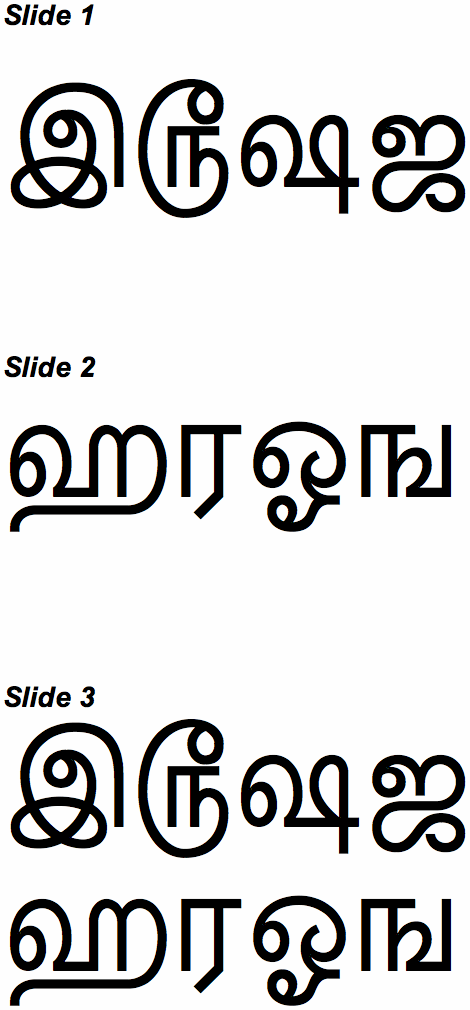THIAGI GAMELETTER:
October 2012
SERIOUSLY FUN ACTIVITIES FOR TRAINERS, FACILITATORS,
PERFORMANCE CONSULTANTS, AND MANAGERS.
TABLE OF CONTENTS
Masthead
Our mission statement, copyright notice, and cast
of characters.
US Workhops
A Special Invitation from Thiagi
And you get a discount, too!
Card Game
Best Picture
Illustrating a concept.
Card Game
Games with Practical Advice Cards
Some games to play with different
topics.
Guest Gamer
An Interview with Karin Hedén
Active learning in Sweden and
Singapore.
Closer
Bus Trip by Karin Hedén
A non-polluting activity.
Twitter
Thirty-Seven Tweets About Distrust and Betrayal
The opposite of trust.
Jolt
The Strengths Advantage by Tracy Tagliati
Can you copy some Tamil letters?
From Brian's Brain
The Biggest Impact: Educator Roles for Better
Learning by Brian Remer
A link to the latest issue of Brian's
newsletter.
Online Survey
Coaching Concepts
Similarities and differences.
Check It Out
Thiagi Double Feature
Thiagi videos on rapid instructional design and
jolts.
Masthead
THIAGI GAMELETTER:
SERIOUSLY FUN ACTIVITIES FOR TRAINERS, FACILITATORS,
PERFORMANCE CONSULTANTS, AND MANAGERS.
Mission
To increase and improve the use of interactive,
experiential strategies to improve human performance in an
effective, efficient, and enjoyable way.
Editorial Roster
 Author and Editor
: Sivasailam (Thiagi) Thiagarajan
Author and Editor
: Sivasailam (Thiagi) Thiagarajan
 Assistant Editor
: Raja Thiagarajan
Assistant Editor
: Raja Thiagarajan
Associate Editors: Jean Reese
Contributing Editors: Brian Remer
Editorial Advisory Board: Bill Wake, Matthew Richter, Samuel van den Bergh, and <type your name here>
Copyright Info
The materials in this newsletter are copyright 2012 by The
Thiagi Group. However, they may be freely reproduced for
educational/training activities. There is no need to obtain
special permission for such use as long as you do not
reproduce more than 100 copies per year. Please
include the following statement on all reproductions:
Reprinted from THIAGI GAMELETTER. Copyright © 2012
by The Thiagi Group, Inc.
For any other use of the content, please contact us (
thiagi@thiagi.com ) for permission.
Subscription Info
To sign up, or to donate and help us continue this
newsletter, please see the Online
Newsletter page on our website (
http://thiagi.com/pfp.html ).
Feedback Request
Thiagi believes in practicing what he preaches. This is an
interactive newsletter, so interact already! Send us your
feedback, sarcastic remarks, and gratuitous advice through
email to thiagi@thiagi.com . Thanks!
[Table of Contents]
US Workhops
A Special Invitation from Thiagi

Basic Information
WHAT? Interactive Techniques for
Instructor-Led Training: A 1-Day Workshop
WHEN? Tuesday, October 30, 2012, 9am-4pm
(Check in at 8:30am)
WHERE? Courtyard by Marriott, Upper East
Side, 410 E 92nd Street, New York, NY, USA. Make your hotel
reservations on the hotel website at http://bit.ly/MXqqcI
.
HOW MUCH? Regular registration rate: $495.
Get $50 off by entering coupon code TGL-NYC when
you register online.
Register Now at http://bit.ly/Nljdca .
BY WHOM? The workshop is designed and
delivered by Thiagi. No bait and switch!
FOR WHOM? Trainers, facilitators,
instructional designers, performance consultants, and
managers.
Workshop Outline
This workshop comes in two parts. In the morning, we focus
on the design and in the afternoon, we focus on the
delivery:
Part 1. Designing Interactive Strategies
The best way to improve your training is to encourage
participants to interact with each other, with the
content, and with you. In this workshop, Thiagi reveals
five secrets of effective interactive training that is
faster, cheaper, and better. Begin by rapidly exploring 60
different training strategies. Later, master additional
details of selected strategies:
-
Structured sharing that helps
practitioners exchange their expertise with each
other
-
Interactive lectures that enable
you to retain control of the session while participants
interact with each other
-
Textra games that transform your
dull, dry handouts and bring them to life
-
Simulation games that use
inexpensive materials and methods to reflect the
realities of the workplace
-
Jolts that last for a few minutes
and provide powerful insights and concepts
With Thiagi's framegame approach, you will learn how to
load your content on to existing templates to create your
own games in a matter of minutes. You will also learn how
to avoid irrelevant fluff and fun, and immerse your
participants in engaging activities.
Part 2. Conducting Training Games and
Activities
Are you excited about training games and activities but
anxious about losing control, wasting time, and being
attacked by participants? Based on 20 years of field
experience and research, Thiagi shares with you three
important secrets of effective training facilitation:
- Identify seven critical dimensions of
activities-based training (including pace, intensity,
competition, and playfulness). Learn how to select,
maintain, and balance appropriate intensities of these
dimensions.
- Recognize participants from hell and their
disruptive behavior patterns. Learn strategies for
discouraging such patterns and specific tactics for
handling each pattern.
- Identify the importance of the debriefing process
for linking the training game or activity to the
workplace reality. Learn a powerful six-phase model for
maximizing learning from experience.
What You Take Home
In addition to your new set of skills and knowledge, you
will have tangible products:
- A manual with ready-to-use training games and
activities and templates for creating your own
- Access to Thiagi's online collection of 350 training
games
- A monthly newsletter with new training activities and
facilitation tips.
Register Today and Save $50
Because you are a reader of TGL, you may
register at the discounted rate of $445 ($50 off the regular
rate). Enter the coupon code TGL-NYC when
you register.
Register for this workshop by calling Brenda at (812)
332-1478, or visiting our online store at http://bit.ly/Nljdca
.
Reserve a room at the hotel by visiting the hotel website
at http://bit.ly/MXqqcI
For more information, download our detailed brochure (169K PDF).
[Add your feedback]
[Return to Table of Contents]
Card Game
Best Picture
Many abstract concepts can be made concrete through the use
of appropriate photographs. How smart are you in selecting the
best picture to illustrate a specific concept?
Synopsis
Each participant selects the best photograph from her hand
to depict a specific concept. All participants vote to
decide which photograph is the best one.
Purpose
To select a photograph that best depicts an abstract
concept.
Participants
Minimum: 3
Maximum: 7
Best: 5
Time
10 to 25 minutes, depending on the number of players.
Supplies
- A deck of Photo cards
- Pieces of paper
- Pens or pencils
Flow
Deal five photos to each player. Ask one
of the players to shuffle the deck of photo cards and deal
five cards to each player, one at a time. The cards should
be dealt photo side down. Each player should pick up the
five cards and study them secretly and carefully.
Study the pictures and select one. Ask the
participants to decide which abstract concept (or concepts)
is strongly associated with each card. Give examples of
concepts such as peace, strength,
trust, and intimacy. Ask the
participants to mentally select the one photograph that has
the strongest association with a specific concept.
Call out the first concept. Select a
participant to name the concept for which she has an
appropriate photograph. All participants should study the
photographs in their hands, select the one that is most
strongly associated with the concept, and place it face
down in the middle of the table. The player who
called out the original concept should also place the card
associated with it in the middle of the table.
Select the best photograph. One of the
players should pick up all the face-down cards from the
middle of the table, shuffle this packet of cards, and deal
them face up. All players should study the photographs and
mentally decide which one is most strongly associated with
the concept. However, no player may select her own card.
When everyone is ready, the player who named the concept
should count to three. At “Three”, each player should
place her finger on the selected card.
Keep track of the score. Each player
should identify the card from her hand and count the number
of fingers touching it. This is her score, and she should
write it down on a piece of paper.
Repeat the procedure. All players take
back the card they played. The players now take turns to
call out a concept, place a selected card face down in the
middle of the table, select the best photograph to depict
the concept, and add their new score to the earlier sum of
scores.
Conclude the game. After each player has
had the opportunity to call out her concept and play a
round, the game comes to an end. The player with the highest
total score wins the game.
Replay the game. To play the game again,
someone collects all the cards, shuffles the deck and deals
five cards to the each player. Game continues as before.
[Add your feedback]
[Return to Table of Contents]
Card Game
Games with Practical Advice Cards
A practical advice card (PAC) contains a useful tip related
to a workplace activity. We have designed several decks of
these PACs. Here is a list of our current topics, each with a
sample practical advice tip:
Customer Service: Actively listen to the
customer's questions and concerns. Repeat back to establish
that you have carefully listened to the customer and clearly
understood the situation.
Coaching for Performance: Ask your
employee to summarize the problem, the solution, and the
action steps.
Interpersonal Trust: Admit your mistakes
as soon as you become aware of them.
Leadership Techniques: Don't provide
solutions. Instead, ask tough questions and let the people
come up with collective answers.
Listening Skills: Avoid multitasking.
Don't check your email, send text messages, read a book,
surf the Internet, or watch the TV. Close the book and turn
off all electronic devices.
Motivation Techniques: Allow team members
to make maximum use of their strengths and talents.
Presentation Skills: Begin with a dramatic
opening that captures the audience's attention within 60
seconds.
In addition to a piece of advice, each card contains a
playing card designation (like 6D or 5C). These card values
are primarily for easy identification and reference (unless
you want to play poker with a PAC deck because you cannot find
your regular deck of cards).
You can read the piece of advice on a card as if it were a
tip for the day. To go beyond mere passive reading,
we have designed several training games to entice people to
discuss, evaluate, and apply the suggestions from these cards.
These games can be played by different numbers of players
(ranging from 1 to 40), and last for different periods of time
(from 5 to 30 minutes).
Here are brief descriptions of seven training games with PAC
decks.
Chat
This game is played in small groups of three to six
players. It encourages the players to conduct in-depth
discussions of each piece of practical advice.
The players take turns reading a piece of advice and
discussing its meaning, utility, potential results, possible
dangers, and alternative uses. At the end of the
conversation around a piece of advice, each player ranks the
relative contribution of the other players. After everyone
had a turn at reading his or her card, the players check
their rankings to determine the winning contributor.
Thirty-Five
This game involves all of the 10-50 players in the room. It
encourages comparative evaluation of different pieces of
advice and the selection of the best ones.
Each player starts with a card with its piece of practical
advice. The players repeatedly exchange their cards. Later,
they pair up randomly. The two players compare the pieces of
advice on their cards and distribute 7 points between them
to reflect their relative values. They repeat the process of
exchanging the cards, pairing up with each other, and
comparatively evaluating two pieces of advice for a total of
five times. In the end, the cards with the highest total
scores are identified as the winning pieces of advice.
Triads
This is a three-person game. It encourages the players to
discuss the potential advantages and possible disadvantages
of different pieces of advice.
Each person in the group of three reads a piece of advice.
The other two players debate on the positive and the
negative consequences of implementing this piece of advice.
The person who originally read the advice now synthesizes
what he or she heard from the other two players and suggests
suitable guidelines on how to increase the advantages and
decrease the disadvantages. Finally, each player scores the
presentations of the others.
Explain and Decide
This game can be played with 12 to 60 participants,
organized into groups of three. It encourages the
participants to compare and discuss the pieces of advice on
different cards.
In each group of three, two of the participants (called
Explainers) have practical advice cards; the third one
(called Decider) does not. The two Explainers take turns to
read the piece of advice from their cards and explain its
potential application. The Decider quietly listens to these
explanations and immediately selects the better piece of
advice. The game continues with the Explainers getting
replacement cards and forming new triads.
Suits
This game can be played in groups of 4 to 40. It encourages
the players to evaluate the pieces of advice, select the
best ones, and attempt to persuade the others on their
merit.
Each player is given 13 practical advice cards. The player
selects the two best pieces of advice. Later, players with
the same sets of cards discuss their choices and arrive at a
consensus. Still later, players with different sets of cards
compare their choices and narrow them down to the best three
across different sets of cards.
Triple Filter
This game can be played by an individual, a pair of
partners, or a team. It encourages the players to explore
different dimensions of each piece of advice.
The player (or the pair or the team) begins with 20 cards
and sorts them into four piles according to the potential
impact of implementing the piece of advice on each card.
Working with the high-impact cards, the player sorts them
into categories based on how frequently each piece of advice
can be used and how easily it can be implemented. Based on
these sorting and resorting activities, the player
identifies pieces of advice that would produce a high return
on investment.
Mingle and Market
This game can be played in groups of 8 to 40. It encourages
people to analyze a piece of advice and convince other
people of its value.
The players are divided into four groups. Each group is
given a single practical advice card. Group members discuss
this piece of advice and come up with strategies for
“pitching” it to the others. Later, participants hold
a series of one-on-one conversations during which they
attempt to persuade each other about the value of the piece
of advice they received. In the end, all players participate
in a poll to select the best among the four pieces of
advice.
One a Week
This unusual activity is for a year and is played by an
individual. It encourages the player to master one practical
piece of advice each week and enhance its application.
The player chooses a practical piece of advice on the first
day of each week. During each subsequent day of the week, he
or she plans and implements this piece of advice. At the end
of each day the player reflects on the experience and gives
himself or herself a score to reflect the depth of learning
and the impact of the implementation.
But Wait, There's More…
We are currently creating more games that can be played
with decks of practical advice cards. In the meantime, these
seven games should give you a feel for how to make use of
this type of card games to improve your participants'
performance.
[Add your feedback]
[Return to Table of Contents]
Guest Gamer
 Karin Hedén has been
a passionate facilitator and trainer for more than 10 years.
She is the founder of Resultatbolaget (“The Results
Company”), an organization that helps companies to
become more successful by developing their leaders and
employees. She is a curious and creative person who likes to
experiment with new games and activities. Her work has taken
her from Sweden to Southeast Asia and to South America.
Karin Hedén has been
a passionate facilitator and trainer for more than 10 years.
She is the founder of Resultatbolaget (“The Results
Company”), an organization that helps companies to
become more successful by developing their leaders and
employees. She is a curious and creative person who likes to
experiment with new games and activities. Her work has taken
her from Sweden to Southeast Asia and to South America.
An Interview with Karin Hedén
TGL: Karin, what is your specialty
area?
Karin: I mostly train managers in order to
develop their leadership and communication
skills.
TGL: How did you get into designing and using
games?
Karin: In 2003, I went to a workshop in
Sweden and it blew my mind how much more I could get out of
meetings and training sessions using simple techniques that
did not cost anything. Six year later, while I was living and
working in Malaysia, I spontaneously signed up for a workshop
in Singapore that was conducted by Tracy and Thiagi. It
reinforced my realization that I could do my training sessions
so much better.
TGL: How long have you been designing and
using games?
Karin: For about 10 years.
TGL: Where do you use games?
Karin: Whenever I conduct training sessions
or facilitate meetings.
TGL: How do your clients
respond?
Karin: They are surprised by the amount of
energy and engagement among the participants. They are
particularly impressed by the enthusiastic discussion of
topics that were traditionally ignored by the
participants.
TGL: How do your participants
respond?
Karin: They have a great time and learn new
skills and knowledge. When participants say they have had the
best meeting ever, I tell them it was all due to their
participation. After all, they did all the work, not
me.
TGL: What is the most horrible or
embarrassing moment you had in conducting games?
Karin: I once asked a small group of four
people if they wanted to try a cash game. After they agreed, I
conducted the Dollar Auction. Two of
the participants got extremely upset. They thought it was an
awful game and accused me of all sorts of evil intentions. It
was a really challenging event. Now looking back on it, I have
learned that mixing money with training games can produce
highly emotional reactions. As a result of this incident, I
have learned to be more careful when conducting cash
games.
TGL: What advice do you have for newcomers
about interactive training?
Karin: Be brave and try new things. People
like to have fun while they are learning and working. Before
you conduct an activity, try to be a participant in that
activity. When you experience the activity from the
participant's point of view you can use your experience when
debriefing the game.
TGL: What types of games do you use most
frequently?
Karin: I use games that let the participants
come up with their own ideas and discuss them with each other.
Framegames like Envelopes and
Hello are very good for this
purpose.
TGL: What is your favorite
game?
Karin: Definitely
Barnga. I have used this game in many
different contexts including intercultural communication and
conflict management. I think it is a great activity that
evokes a lot of emotions and produces a lot of
insights.
TGL: What is your prediction about the future
of games?
Karin: I think there will be more and more
learning games. My sons who are 4 and 6 are already playing
games on Wii, iPad, and iPhone. This summer, my oldest son
learned how to read thanks to a great app on my smart phone. I
think our next generation will expect games to be included
whenever they are going to learn something. I also think there
will be a lot more computerized learning games.
[Add your feedback]
[Return to Table of Contents]
Closer
Bus Trip
by Karin Hedén
 This is one of my favorite
feedback games. I use Bus Trip at the
end of a training session or a meeting, and I use it all the
time. The game creates a massive amount of energy with lots of
smiles, laughs, and sometimes even a teardrop or two.
This is one of my favorite
feedback games. I use Bus Trip at the
end of a training session or a meeting, and I use it all the
time. The game creates a massive amount of energy with lots of
smiles, laughs, and sometimes even a teardrop or two.
Participants
10 to 30
Time Requirement
20 to 45 minutes
Setup
Put as many chairs as there are participants in two rows.
Place the chairs tightly, facing each other. If there is an
odd number of participants, put a single chair in front for
the bus driver.
Flow
Brief the participants. Welcome them to a
great new invention. Explain that you have a fantastic bus
that does not pollute the air, because it runs on positive
energy. On this bus everyone gets to speak with everyone and
they are for sure going to have a great trip together.
Load the bus. Ask the participants to go
and sit on the chairs, close to each other so the knees are
nearly touching each other. If there are odd numbers of
participants, one person will play the bus driver and will
just listen.
Start giving positive feedback. Ask the
participants in one row to give as much positive feedback as
possible to the participants seated in the opposite row (who
will listen quietly). Give the following types of
examples:
What I like about you is…
What I appreciate about you is…
I feel happy whenever you…
Announce a time limit of 45 seconds.
Change the roles. After 45 seconds, blow a
whistle and pause for 10 seconds. Then ask the participants
in the other row to take their turn.
Rotate the participants. After 45 seconds,
it is time to rotate the passengers. If you have an even
number of participants, select one person to stay on the
same chair. Ask everyone else to rotate one chair clockwise.
If you have an odd number of participants, ask everyone to
rotate one chair clockwise. This will result in a new person
becoming the bus driver.
Continue the positive conversations. As
before, ask the participants in the two rows to take turns
sharing positive feedback. Keep rotating the participants
depending on the available time.
Debriefing
Conduct a debriefing discussion after several rounds of
this activity. Ask the participants to discuss what happens
when people give positive and appreciative feedback. Talk
about the energy created in the room. Ask them how they can
give more positive feedback within this group, within the
organization, and in their families.
[Add your feedback]
[Return to Table of Contents]
Twitter
Thirty-Seven Tweets About Distrust and Betrayal
I'm working on a training package on improving interpersonal
trust. I'm using twitter to help me share some preliminary
ideas. Here are some of my recent tweets on this topic.
Follow me on Twitter @thiagi .
- The opposite of trust is distrust, or doubt, or
suspicion.
- Building trust requires time. Distrust also builds over
time.
- Betrayal results in sudden loss of trust. It can happen
instantly.
- Betrayal can be intentional or accidental.
- Betrayal can be minor or major.
- Betrayal can be related to different trust
factors.
- Betrayal: Your friend used the discount coupon that was
sent to you.
- Betrayal: Your friend has not responded to an email you
sent 2 weeks ago.
- Betrayal: You friend pretends to be open-minded. You
discover that she's a bigot.
- Betrayal: Your friend pretends not to recognize you at a
party.
- Betrayal: Your friend claims to be an expert in
leadership but does not know what situation leadership is
about.
- Betrayal occurs more frequently than you imagine.
- In multicultural organizations, accidental betrayals
occur frequently.
- Recovering from betrayal and rebuilding trust is a tough
task.
- Recovering from betrayal is both a healing and learning
experience.
- Whether you feel betrayed or you have betrayed others,
bring it out in the open.
- If you feel someone has betrayed you, don't rush into
fight or flight. Take time to reflect.
- Think about the act of betrayal. Be specific about what
happened. Figure out what type of trust was broken.
- Did someone betray you by a selfish act? Should you not
put the other person's interests above your
interests?
- Did someone betray you through an unpredicted behavior?
What alternative reasons can you come up with?
- Did you discover that the other person is insincere?
Have you been putting the other person on a pedestal?
- Has your relationship cooled off? Are you confusing
jealousy with betrayal?
- Have you discovered the other person's areas of
incompetence? Is competence more important than the other
factors?
- To handle betrayal, talk directly with the other person.
Explain your perceptions of what happened.
- To handle betrayal be ready to conduct a crucial and
difficult conversation. Ask for the other person's
story.
- When you listen to the other person's explanation of a
betrayal incident, keep your mind open and your mouth
shut.
- In talking about an act of betrayal, explain to the
other person what you need to regain the trust. Be
reasonable.
- In discussing betrayal, focus on the future. As Lily
Tomlin said, “Give up all hopes for a better
past.”
- Make it easy for the other person to identify your acts
of betrayal and talk about them. Otherwise, you may have
difficulty realizing what happened.
- Recognize avoidance, silence, and sarcasm as indicators
of betrayal. Ask for a direct conversation.
- When a person accuses you of betrayal, don't get
defensive. Immediately and unconditionally accept and
apologize.
- Probe the feelings of betrayal to discover
misunderstanding. Do this to understand, not to come up with
excuses.
- It is the impact, not your intent, that results in other
people's feelings of betrayal. To them intentional and
accidental are the same.
- Remember, when you intentionally betray the other
person, you are betraying yourself.
- Intentional betrayal may make you feel guilty, ashamed,
and embarrassed. Face these feelings—and move
on.
- To recover from a betrayal incident, accept your action.
Apologize. Make amends.
- Figure out the cause of betrayal and how to avoid a
repetition. Talk it out openly and honestly.
[Add your feedback]
[Return to Table of Contents]
Jolt
The Strengths Advantage
by Tracy Tagliati

Synopsis
The participants copy Tamil letters. The first time they
use their dominant hand and the second time they use their
less dominant hand. A comparative analysis confirms that the
results are better when the participants use their dominant
hand. The debriefing that follows reveals that they are also
more confident and less stressed when using their dominant
hand.
Purpose
To demonstrate how we can leverage strengths to perform
better.
Training Topics
- Strengths-Based Learning
- Happiness
- Stress
Supplies
Participants
One or more
Time
3 minutes for the activity.
3 minutes for the
debriefing.
Flow
Distribute paper and pens. Give each
participant a piece of paper and a pen or pencil.
Brief the participants. Explain to the
participants that they will all be learning to write letters
in Tamil.
Provide instructions for round one. Ask
the participants to raise their less dominant hand. Instruct
them to use this hand during the round. Show the PowerPoint
slide with the first set of Tamil letters and announce a
30-second time limit to copy the Tamil letters as they
appear on the slide.
Provide instructions for round two. At the
end of 30 seconds, stop the activity. Ask the participants
to raise their dominant hand and tell them to use this hand
during the second round. Distribute a new piece of blank
paper. Show the PowerPoint slide with the second set of
Tamil letters and announce another 30-second time limit.
Tell the participants to copy these letters on a new piece
of paper.
Form pairs. Ask the participants on the
right side of the room to pair up with someone on the left
side of the room. Ask them to exchange both pieces of paper.
Project the third slide with both sets of Tamil letters and
ask the participants to distribute 7 points between the two
pieces of paper to reflect the quality of writing. Give
examples of 7-point distributions: 4 and 3, 5 and 2, 6 and
1, or 7 and 0. Tell participants to avoid using fractions or
negative numbers. When they are done, ask the members of
each pair to return the papers to the original author.
Debriefing
In your own words conduct a debriefing discussion by asking
these types of questions:
Which hand produced better results: your dominant hand or
your less dominant hand?
Did you feel more or less confident when using your
dominant hand?
Were you more or less stressed when using your dominant
hand?
Were you more or less engaged when you were using your
dominant hand?
How does this relate to the activities in your
workplace?
Learning Point
People who use their strengths perform better and are more
confident, engaged and less stressed.
Want to read more about empirical evidence?
Govindji, R., & Linley, P. A. (2007). Strengths use,
self-concordance and well-being: Implications for strengths
coaching and coaching psychologists.
International Coaching Psychology
Review, 2 (2), 143-153.
Tamil Letters

[Add your feedback]
[Return to Table of Contents]
From Brian's Brain
The Biggest Impact: Educator Roles for Better
Learning
by Brian Remer

Sometimes how we teach is as important as
what we teach. David Kolb, father of the
Experiential Learning Cycle, has developed an assessment tool
to help all teachers—whether or not they are formal
educators—to identify their preferences among four
educator roles. This issue will explore these roles and how to
use them to maintain momentum through the learning cycle.
Power Tip: Asking the right questions can
help people become better learners.
Read more in the September 2012 issue of Firefly News
Flash: http://www.thefirefly.org/Firefly/html/News%20Flash/2012/September%202012.htm
.
[Add your feedback]
[Return to Table of Contents]
Online Survey
Coaching Concepts
In our Four Suits card game, we ask
the players to compare two related concepts and come up with
the one important similarity and one important difference.
This comparison activity forces the players to analyze the
concepts carefully and learn more about them.
Here’s a sample pair of concepts from the Four
Suits deck on Coaching for Success:
- Sports coaching
- Business coaching
Here's a sample response:
Similarity: Both activities focus on improving individual
performance.
Difference: Sports coaching frequently involves physical
skills while business coaching frequently involves
interpersonal skills.
This month’s online survey asks you to compare another pair
of concepts associated with performance coaching. Reflect on
these two concepts and type one similarity and one difference
between them.
Open Question
Compare these two coaching techniques:
- Face-to-face coaching
- Telephone coaching

(The survey opens in a new window.)
You may include your name along with your response, or if
you prefer, keep it anonymous.
[Add your feedback]
[Return to Table of Contents]
Check It Out
Thiagi Double Feature
Here are two videos of presentations by Thiagi.
The first video, recorded at University of Maryland Baltimore
County, is over 100 minutes long and deals with rapid
instructional design. Watch Thiagi present his irreverent
approach: http://www.youtube.com/watch?v=CYqm8ao1i2c . Nearly
18,000 people have watched the video so far.
The second video, recorded at this year's Creative Problem
Solving Institute in Atlanta, is nearly 30 minutes long. You
can watch Thiagi facilitating and debriefing a series of
jolts: http://vimeo.com/46039538 .
Enjoy!
[Add your feedback]
[Return to Table of Contents]
 Author and Editor
: Sivasailam (Thiagi) Thiagarajan
Author and Editor
: Sivasailam (Thiagi) Thiagarajan Assistant Editor
: Raja Thiagarajan
Assistant Editor
: Raja Thiagarajan
 Karin Hedén has been
a passionate facilitator and trainer for more than 10 years.
She is the founder of Resultatbolaget (“The Results
Company”), an organization that helps companies to
become more successful by developing their leaders and
employees. She is a curious and creative person who likes to
experiment with new games and activities. Her work has taken
her from Sweden to Southeast Asia and to South America.
Karin Hedén has been
a passionate facilitator and trainer for more than 10 years.
She is the founder of Resultatbolaget (“The Results
Company”), an organization that helps companies to
become more successful by developing their leaders and
employees. She is a curious and creative person who likes to
experiment with new games and activities. Her work has taken
her from Sweden to Southeast Asia and to South America. This is one of my favorite
feedback games. I use Bus Trip at the
end of a training session or a meeting, and I use it all the
time. The game creates a massive amount of energy with lots of
smiles, laughs, and sometimes even a teardrop or two.
This is one of my favorite
feedback games. I use Bus Trip at the
end of a training session or a meeting, and I use it all the
time. The game creates a massive amount of energy with lots of
smiles, laughs, and sometimes even a teardrop or two.


